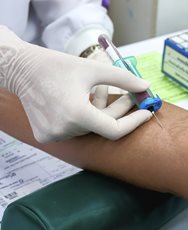Tips When Having Blood Drawn
 The information provided by blood tests often is critical for your physician to make decisions about your health care. Nobody likes to have blood drawn, but the procedure should not be overly unpleasant. Each patient’s veins are a little different. Plump, engorged veins are ideal for blood draws, but if you have small veins or veins that tend to “roll,” there still are some simple steps you can take to improve the experience.
The information provided by blood tests often is critical for your physician to make decisions about your health care. Nobody likes to have blood drawn, but the procedure should not be overly unpleasant. Each patient’s veins are a little different. Plump, engorged veins are ideal for blood draws, but if you have small veins or veins that tend to “roll,” there still are some simple steps you can take to improve the experience.
- Hydrate. Dehydration increases the risk that your vein will collapse during a blood draw. Unless you have been instructed not to eat or drink anything before the test, start drinking water 24 hours in advance. It is not necessary to drink excessive amounts of water – 64 ounces over 24 hours should be plenty.
- Avoid caffeine. As a diuretic, caffeine forces fluids into the kidneys and constricts the veins.
- Stay warm. Especially in cold weather, wear warm clothing and allow your body to warm up inside the building for several minutes before having your blood drawn. This will improve your blood flow.
- Walk briskly and shake hands vigorously. Activity will promote a stronger blood flow.
- Do arm curls. If you know in advance that you will have a blood test, it may help to build up muscle tissue by lifting weights or using dumbbells. As the muscles expand, blood flow is increased, and veins are moved closer to the surface.
- Schedule the visit later in the day. Veins tend to be flatter in the early morning. Unless you have been instructed to fast, enjoy a full breakfast or lunch before the blood draw.
- Sit very still. If you squirm or flinch during the blood draw, it will be more difficult for the phlebotomist to insert the needle smoothly.
- Breathe. Holding your breath can make you feel lightheaded. Just breathe normally during the blood draw.
- Do not look. Focusing on the needle may intensify your apprehension or discomfort. Try taking a book or another method of distraction.
- Talk about your concerns. Many patients are fearful of needles or the sight of blood. Phlebotomists can help with these fears, but only if they know in advance. If you are fearful of the pinprick, the phlebotomist may be able to apply a numbing agent. It is especially important to let someone know if you feel lightheaded or have fainted during previous blood draws so that special measures can be taken to prevent possible falls.
| Posted On : 1/20/2016 8:50:24 AM